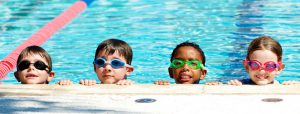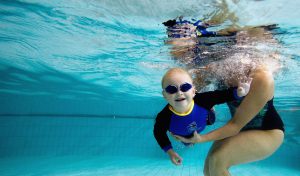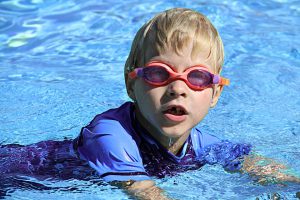Swim Lessons: The Do’s and Don’ts

Can we all just stop for a moment and discuss that it is March already? MARCH. Where did winter go? As we enter into the warmer months one thing is on our mind: Swimming. We are trading in our snow boots for bathing suits and getting ready to jump in. Swimming is a summertime staple and has always been a big part of KING Summer Camps but this year we are upping the ante and offering swim lessons for the first time. This news inspired us to share some Do’s and Don’ts of swim lessons and what you can expect from KING swim lessons (hint: it’s the do’s!).
Don’t: Use floaties. Yes, they are cute and probably have your child’s favorite Disney character printed on them, but don’t be tricked. A child floating with blow up floaties does not equate to being able to swim. The floaties actually make the child bob up and down vertically and forces the child to kick with improper form. This creates a habit that is very hard to break in swim lessons.
Do: Be aware of the swim environment. If the lessons are outdoors sunscreen is a must. If the lessons are indoors, ask what type of pool are they going to be in. A typical competition pool is kept around 80 degrees. For younger swimmers this temperature can be chilly and can deter them from having a productive lesson (picture shivering kids sitting on the edge of the pool). Rashguards and thin swimmer wetsuits can be awesome solutions for youngsters that tend to get cold. Be aware that cotton t-shirts or additional clothing will not aide in keeping the swimmer warm and will be detrimental to swim progress.

Do: Find balance between age and ability for swim groups. Swim lessons are a great place to make friends but swimming ability/confidence does not correlate with age in the same way that other land sports do. This isn’t to say you want to group a 5 year old “future Michael Phelps” with 12 year olds, as you still want to be sensitive to social and emotional factors. However, a 6-year-old could be jumping in and ready to rock in roll, whereas a 10-year-old could be digging their fingernails into the instructor’s arm out of complete fear of the water. Finding the balance between ability and social factors is key from successful group lessons. If your lesson provider isn’t doing a pre-lesson swim test, consider it a red flag.
Don’t: Assume your child will be the “Future Michael Phelps after 1 lesson. There are a million and two factors that go into the learn-to-swim process. Each child will learn at different speeds and that is okay. Celebrate the small victories, such as the first time your child floats on their back, or the first time they dunk their whole face under the water. Not every child will be a competitive swimmer, but it is our hope every child will be a safe swimmer.
Do: Bring goggles to lessons! 1) Simply, chlorine is not the most pleasant thing for eyes! 2) Many good swim instructors will communicate through hand gestures while the swimmer’s face is under water. We want the child to be able to see that communication. 3) Goggles often raise the confidence levels of the child. Similar to a cool new pair of basketball shoes, goggles will make the child want to “act the part” and gets them ready to rock the lesson.

Don’t: Take for granted the life skill that swimming is. Swimming is a sport that can be enjoyed at all ages. Learning to be a safe swimmer will build confidence in both the parent and the child when going to the beach, taking a boat ride, jumping off that diving board. Basically, everyone should learn to swim!
For more information on all Kids in the Game programing check out our website or email info@kidsinthegame.com